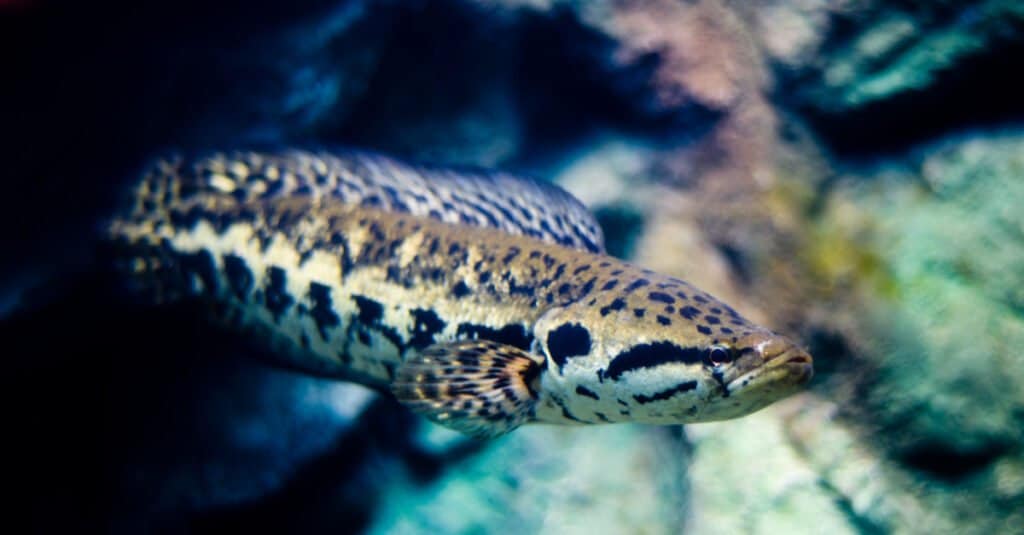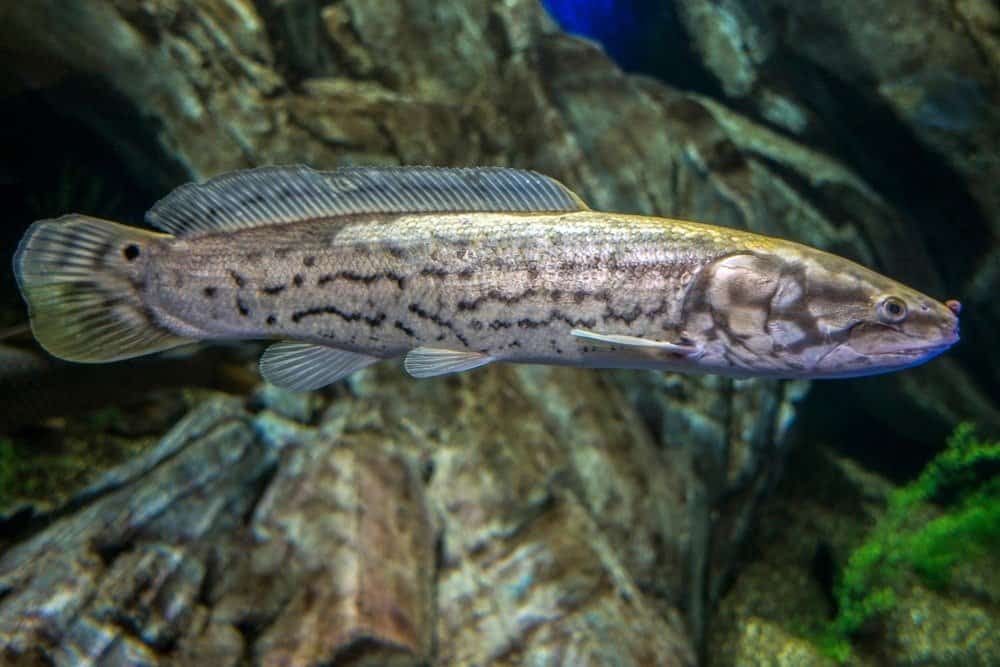It’s not the northern snakehead’s fault that it has become a pest and a terror in the Lower Susquehanna River. This one-of-a-kind fish is native to rivers that drain into the Pacific Ocean where it borders northern Asia. There, people raise it for food. It was only when it was brought to the United States and other places that this otherwise innocent fish began to cause havoc.
Scientists believe that the northern snakehead became problematic when it was released into the American wild by people who found it hard to handle as a pet. People even dumped the snakehead into the nearest body of water after they’d bought it from a live-food market with the intent to eat it. These liberated fish found their new environment perfect for their needs, and the first nest of northern snakeheads was discovered in a Maryland pond in 2002.
What’s the Problem?

This one-of-a-kind fish causes problems where it is introduced.
©Narongchut/Shutterstock.com
The problem with this one-of-a-kind fish is that it can thrive in a great variety of conditions. This includes turbid, poorly oxygenated water. It can also breathe air and can live out of water for a few days. It can even leave one body of water, wriggle across a small patch of land and slip into another body of water. The one thing the fish can’t tolerate is salt water. Also, the northern snakehead eats anything it can handle, and if it can’t eat it, it outcompetes it. It reproduces as much as five times a year, and the female lays between 1,300 to 15,000 eggs at a time. These eggs usually hatch within two days, especially if the water is warm. Not only this, introduced snakeheads start to reproduce at an earlier age than those back in its native Asia even as they don’t spawn as often.
First Sighted in 2020
The snakehead was first found in the Lower Susquehanna around 2020 and has been monitored ever since. In the summer of 2023 fishermen and biologists spotted snakeheads in the Conowingo Reservoir, and there were signs that they were reproducing. The snakeheads most likely got into the reservoir by getting into the fish lift on the Conowingo Dam.
Both the Maryland Department of Natural Resources and the Pennsylvania Fish and Boat Commission manage the Conowingo Reservoir. Officials warn fishermen who catch snakeheads to kill them immediately and to report them to the PFBC. Indeed, it’s illegal to even possess a live northern snakehead in Maryland and Pennsylvania. There’s no limit to how many a fisherman can catch or the size of the fish.
Fishermen can dispatch the northern snakehead by tearing out its gills, beheading it, or eviscerating it. The dead fish make good garden fertilizer, or they can be simply thrown in the trash. Snakeheads also make good eating, and China and Korea harvest 500 tons of these fish every year for the table.
How to Tell the Snakehead From Other Fish

The bowfin is often mistaken for the northern snakehead.
©Miroslav Halama/Shutterstock.com
The snakehead’s body is long and cylindrical, with some adults approaching 4 feet in length. The ground color is dark brown or tan, with dark blotches. The hide of the fish can be said to resemble the hide of a python, and the sizable scales on the fish’s head also resemble the scales on the head of a snake. This gives the fish its name. The snakehead also sports a long, unbroken dorsal fin and long anal fins.
The northern snakehead’s single dorsal fin might make people mistake it for the bowfin. But the bowfin’s anal fin is short, and its head doesn’t have those large, reptilian scales. Its pelvic fins are also found further back on its body than the pelvic fins of the snakehead. Another fish you might mistake for the snakehead is the burbot. The burbot has a barbel on its chin, its scales are small, and its anal fin is also shorter than that of the snakehead. It also has a pair of dorsal fins.
More About This One-of-a-Kind Fish
Along with its other characteristics, this one-of-a-kind-fish has a protrudent lower jaw full of sharp teeth and eyes at the front of its head. Females are smaller than males, and adult fish weigh between 4 and 17.6 pounds.
The snakehead’s breeding season starts in June and continues until October. Both parents build a nest out of aquatic vegetation, then the female lays her eggs atop it. The eggs float because they’re full of fat. The male then swims over the eggs and fertilizes them. Both parents guard the fry for about a month until they’re able to fend for themselves. Because of this, snakeheads are considered exemplars of parental devotion in Chinese folklore. Northern snakeheads aren’t long-lived fish and live for about three to six years. They make up for this by doubling their population every 15 years or so.
Northern snakeheads also hunt at twilight or early nighttime, so this may be the best time to catch them. They also hunt in schools, and their forward facing eyes have evolved to see well in dim light. They’ll eat other fish, amphibians, insects and small fresh-water crustaceans. Snakeheads also catch insects and other small animals they see on branches overhanging the water. In some areas the snakehead is large enough to be the apex predator. It is not preyed upon by any other non-human animal.
The photo featured at the top of this post is © USGS, Public domain, via Wikimedia Commons – License / Original
Thank you for reading! Have some feedback for us? Contact the AZ Animals editorial team.







